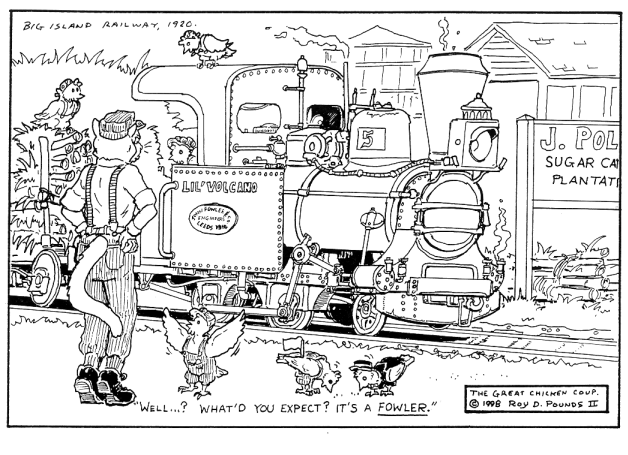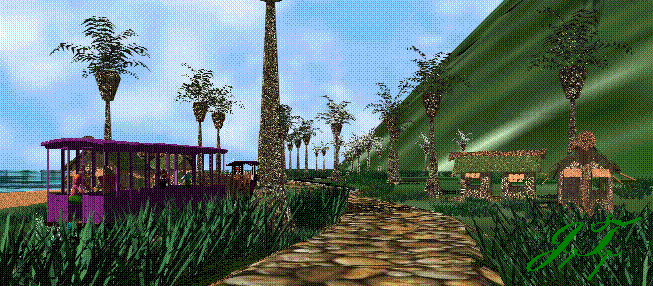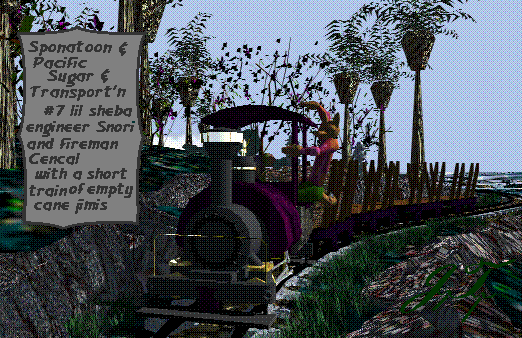Spontoon Island
home
- contact - credits
- new - links - history
- maps - art - story
## update 27 May 2003 ##
Railways
Tramways, trolley lines, industrial
railroads of Spontoon Island
(with some general references
from 1890-1950)

Big Island Railway, 1920: "The Great Chicken Coup" © 1998 Roy
D. Pounds II
A short historical overview
(by Ken Fletcher)
Some railroads & tramways were on the Spontoon Islands by the end
of the British
colonial administration, before 1890. They were mostly for moving goods
and harvests
in the agricultural plantations to processing mills or boat landings.
All were
‘narrow gauge’, with 2-feet or 3-feet width between the tracks, with
light-weight track
& light equipment. Most of the light freight railcars were moved
by Spontoonies pushing.
For some railways, the track was portable and could be moved in sections,
with
cross-ties (‘sleepers’) and track attached together in standard lengths.
When Spontoon Island became independent, the Althing wished to improve
transportation in the atoll. Small boats and docks were the most useful
for getting around
between islands and along the coasts, but the Spontoonies also wanted
better land
transport. Walking & horse-trails were improved, but many main
trails were upgraded to
bicycle-friendly paths. In addition, many of the main trails were supplimented
by nearby
railway tracks. These Co-op railways used the equipment already available
on the islands,
supplemented by purchasing used equipment and track from many sources
in the Pacific
region. Tracklaying & design assistance came from off-island civil
engineers working
on contract. Spontoonies did most of the labor. There was some standardization
of the
rail equipment, 2 ½-foot gauge being most used, but some light
feeder tramways
were in other gauges. The use of railways was at its peak about 1915.
The mostly second-hand equipment was from all over the map. Locomotives:
Some
small British-pattern steam engines (0-4-0, 2-4-0 and 0-4-2) with built-in
water tank and
fuel box. There were some USA-pattern geared steam engines (Heisler
was a favorite
manufacturer) for heavier work loads. Freight & passenger cars
were pre-owned from
all over the Pacific, with local modifications. An attempt was made
to have a
standardized coupling system. Fuels used for the steam engines (not
all at the
same time!): agricultural trash, coal, & fuel oil.
Most noteable of the rail lines was the 2 ½-foot gauge mainline
along the south coast
of the Main Island. It had regularly scheduled (but small) freight
and passenger trains.
Eastern Island & South Island had some light rail line trackage
for moving plantation
products. Casino Island had some railways for moving freight between
docks and
warehouses. Some of this equipment & trackage was privately owned,
though connected
with shared trackage rights between some of the docks. Most of the
rail lines were run
by an Althing Railroad Committee, sometimes well, sometimes not so
well.
By the early 1920s, truck and automobile transportation seemed more
appealing.
Rail service was abandoned in sections, sometimes with the railroad
grade being
converted to an auto road. By 1925, the main rail lines were dismantled
and
replaced by truck and auto roads. Some sections of grade were abandoned
and became overgrown with vegitation, or became foot trails. Most of
the
equipment was sold, with some in storage. Some short plantation tramway
sections
were still in use, and there were still short sections of dockside
trackage in use
(at times) on Casino Island, Moon Island, and Eastern Island. Most
of these railways
are associated with moving heavy equipment at repair facilities or
moving heavy
freight items. The motive power for the freight cars was often tractors
or heavy trucks,
with only a couple of the remaining geared steam engines fired-up and
operated
when needed (or for fun).
By the late 1930s some of the disadvantages of relying on only motorcars
and trucks
are more obvious. Casino Island even has traffic jams at times!
The Althing
was beginning to be aware of ecology problems. There was also a lot
of nostalgia
for the steam trains. When approached by an outside contractor, the
Althing
was willing to consider experimenting with railway service again.
Spontoon & Pacific
Sugar & Transportation
Co.
from the archives of John Teall (text & pictures)
circa 1939-1940
This company restored a tramway system for agricultural, light industrial,
and passenger transport, starting with track along the northern edge
of
South Island, along the area of the tourist resorts.

